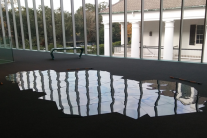Assistant Professor of Art History Christopher Bennet Curates and Writes Catalogue for Two New Exhibitions.
Thu, 02/02/2017 - 2:53pmLee’s installations incorporate sculptural, photographic, and drawing traditions to consider ways in which place is created among changing urban and environmental conditions. The sculptures and installations she constructs are informed by her observations of daily life and through the collecting and reconfiguring of the materials that pass through it.
This solo exhibition marks Lee's first in Louisiana and is guest curated by Dr. Christopher Bennett, UL Lafayette Art History professor in the Department of Visual Arts. It is accompanied by a new publication by the museum, also authored by Bennett, which features an analysis and catalog of Lee's recent artworks.
Curatorial Statement:
Sandra Eula Lee makes use of ordinary, and at times site-specific, materials to construct two- and three- dimensional arrangements. Currently the director of the Expanded Sculpture Program at Kenyon College in Ohio, Lee uses materials salvaged from construction sites in her art. Working with materials gathered during travels through South Korea, China, and the United States, she configures work that explores the theme of the “garden”—principally as an East Asian formation—and the “ponds” often located within them.
As a former resident of five bustling cities—Goyang, Seoul, Xiamen, Beijing, and New York City—where Lee lived between 2000 and 2015, Lee experienced a larger atmosphere defined by accelerated modernization and continual construction. She was especially struck by small, ‘impromptu’ gardens, created and tended by anonymous civilians, located between the many construction zones and apartment blocks and along the peripheries of such places. Soon, she began to think about how the “garden” might be brought to bear on making a work of art.
As an artist Lee conceives the “garden” as a space of contemplation; it is also, like life itself, in her estimation, “improvised.” Inspired by more formal gardens, such as Soswaewon Garden in South Korea or The Master of Nets Garden in Suzhou, China, Lee is particularly drawn to the ponds located within gardens. She describes such a pond as “almost a kind of empty space, reflecting what’s around it.”
The exhibition Make of / Make do surveys Lee’s production from 1997 to 2014 and includes her most recent works of 2015-17. In these later pieces, the themes of her earlier “gardens” and “ponds” undergo projection onto the vertical plane of the wall and onto new landscape features, such as mountains.
Lee’s art is defined by a dynamic tension between the spontaneous and potentially endless process of making use of salvaged and commonly available materials—and the arrival at a finely-tuned, definitive external structure.
Dr. Christopher Bennett
Guest Curator and UL Lafayette Department of Visual Arts Faculty
Acknowledgements:
Sandra Eula Lee: Make of / Make do has been generously supported by the Department of Visual Arts and College of the Arts at the University of Louisiana at Lafayette; Kenyon College in Gambier, Ohio; and the Friends of the Humanities.
YUN-FEI JI: LOOKING FOR LEHMAN BROTHERS
Feb 03, 2017 — May 06, 2017
Yun-Fei Ji is a Chinese-American painter based in Ohio and New York. Growing up in China during the Cultural Revolution, Ji spent some of his earliest years on a collective farm outside Hangzhou where, in the absence of TV and radio, he was entertained by his grandmother’s and other locals’ telling of ghost stories and folk tales.
Ji is a critically-acclaimed contemporary artist. His recent exhibitions include Yun-Fei Ji: Water Work at the Ullens Center for Contemporary Art in Beijing in 2012; the Prospect 3 New Orleans triennial in 2014-2015; Ji Yun-Fei: Last Days of Village Wen at the Cleveland Museum of Art in 2016; and Yun-Fei Ji: The Intimate Universe organized by the Wellin Museum of Art which toured to the Honolulu Museum of Art in 2016-2017. Presently his work is on view at the Metropolitan Museum of Art in New York in the survey exhibition Show and Tell: Stories in Chinese Painting.
Ji is well-known for revivifying the traditional brush-and-ink painting methods associated with earlier periods of Chinese art, including literati landscape painting of the Song Dynasty. He seemingly combines these methods with elements of Western art—the production of the Dada artists Otto Dix and George Grosz, for example, and earlier masters such as Francisco Goya, Hieronymus Bosch, and Martin Schongauer.
As an artist Ji consistently aims to develop a visual language capable of addressing contemporary global events including the pressing issues of environmental crisis, geographical displacement, and the re-making of place. Yun-Fei Ji: Looking for Lehman Brothers features paintings created between 2007 and 2008, including his iconic hand scroll The Three Gorges Dam Migration (2008). In addition to this signature work, the exhibition highlights a suite of paintings and sketches that grapple with the devastation and aftereffects of Hurricane Katrina. These last works by Ji establish parallels between the scope of the great financial collapse of 2008 and Katrina three years earlier, with the focus persistently falling on the lives of ordinary people affected by large-scale crises.
Dr. Christopher Bennett
Guest Curator and UL Lafayette Department of Visual Arts Faculty
Acknowledgements:
Yun-Fei Ji: Looking for Lehman Brothers has been generously supported by the Department of Visual Arts and College of the Arts at the University of Louisiana at Lafayette and the Friends of the Humanities. Artworks courtesy of James Cohan Gallery, New York.



